Tutorial: Microsoft Entra SSO integration with Atlassian Cloud
In this tutorial, you'll learn how to integrate Atlassian Cloud with Microsoft Entra ID. When you integrate Atlassian Cloud with Microsoft Entra ID, you can:
- Control in Microsoft Entra ID who has access to Atlassian Cloud.
- Enable your users to be automatically signed-in to Atlassian Cloud with their Microsoft Entra accounts.
- Manage your accounts in one central location.
Prerequisites
To get started, you need the following items:
- A Microsoft Entra subscription. If you don't have a subscription, you can get a free account.
- Atlassian Cloud single sign-on (SSO) enabled subscription.
- To enable Security Assertion Markup Language (SAML) single sign-on for Atlassian Cloud products, you need to set up Atlassian Access. Learn more about Atlassian Access.
Note
This integration is also available to use from Microsoft Entra US Government Cloud environment. You can find this application in the Microsoft Entra US Government Cloud Application Gallery and configure it in the same way as you do from public cloud.
Scenario description
In this tutorial, you configure and test Microsoft Entra SSO in a test environment.
- Atlassian Cloud supports SP and IDP initiated SSO.
- Atlassian Cloud supports Automatic user provisioning and deprovisioning.
Add Atlassian Cloud from the gallery
To configure the integration of Atlassian Cloud into Microsoft Entra ID, you need to add Atlassian Cloud from the gallery to your list of managed SaaS apps.
- Sign in to the Microsoft Entra admin center as at least a Cloud Application Administrator.
- Browse to Identity > Applications > Enterprise applications > New application.
- In the Add from the gallery section, type Atlassian Cloud in the search box.
- Select Atlassian Cloud from results panel and then add the app. Wait a few seconds while the app is added to your tenant.
Alternatively, you can also use the Enterprise App Configuration Wizard. In this wizard, you can add an application to your tenant, add users/groups to the app, assign roles, as well as walk through the SSO configuration as well. You can learn more about Microsoft 365 wizards here.
Configure and test Microsoft Entra SSO
Configure and test Microsoft Entra SSO with Atlassian Cloud using a test user called B.Simon. For SSO to work, you need to establish a link relationship between a Microsoft Entra user and the related user in Atlassian Cloud.
To configure and test Microsoft Entra SSO with Atlassian Cloud, perform the following steps:
- Configure Microsoft Entra ID with Atlassian Cloud SSO - to enable your users to use Microsoft Entra ID based SAML SSO with Atlassian Cloud.
- Create a Microsoft Entra test user - to test Microsoft Entra single sign-on with B.Simon.
- Assign the Microsoft Entra test user - to enable B.Simon to use Microsoft Entra single sign-on.
- Create Atlassian Cloud test user - to have a counterpart of B.Simon in Atlassian Cloud that is linked to the Microsoft Entra representation of user.
- Test SSO - to verify whether the configuration works.
Configure Microsoft Entra ID with Atlassian Cloud SSO
Follow these steps to enable Microsoft Entra SSO.
In a different web browser window, sign in to your up Atlassian Cloud company site as an administrator
In the ATLASSIAN Admin portal, navigate to Security > Identity providers > Microsoft Entra ID.

Enter the Directory name and click Add button.

Select Set up SAML single sign-on button to connect your identity provider to Atlassian organization.

Sign in to the Microsoft Entra admin center as at least a Cloud Application Administrator.
Browse to Identity > Applications > Enterprise applications > Atlassian Cloud application integration page, find the Manage section and select Set up single sign-on.
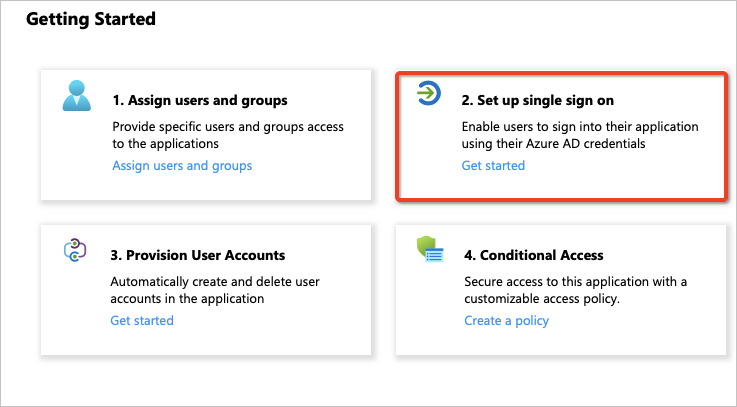
On the Select a Single sign-on method page, select SAML.

On the Set up Single Sign-On with SAML page, scroll down to Set Up Atlassian Cloud.
a. Click on Configuration URLs.

b. Copy Login URL value from Azure portal, paste it in the Identity provider SSO URL textbox in Atlassian.
c. Copy Microsoft Entra Identifier value from Azure portal, paste it in the Identity provider Entity ID textbox in Atlassian.
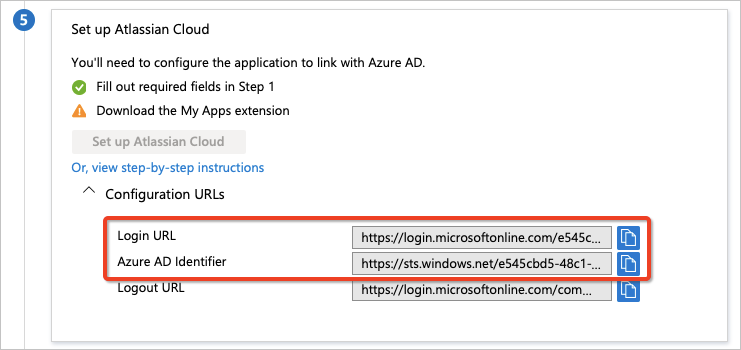

On the Set up Single Sign-On with SAML page, in the SAML Signing Certificate section, find Certificate (Base64) and select Download to download the certificate and save it on your computer.


Save the SAML Configuration and click Next in Atlassian.
On the Basic SAML Configuration section, perform the following steps.
a. Copy Service provider entity URL value from Atlassian, paste it in the Identifier (Entity ID) box in Azure and set it as default.
b. Copy Service provider assertion consumer service URL value from Atlassian, paste it in the Reply URL (Assertion Consumer Service URL) box in Azure and set it as default.
c. Click Next.


Your Atlassian Cloud application expects the SAML assertions in a specific format, which requires you to add custom attribute mappings to your SAML token attributes configuration. You can edit the attribute mapping by clicking on Edit icon.

Attribute mapping for a Microsoft Entra tenant with a Microsoft 365 license.
a. Click on the Unique User Identifier (Name ID) claim.
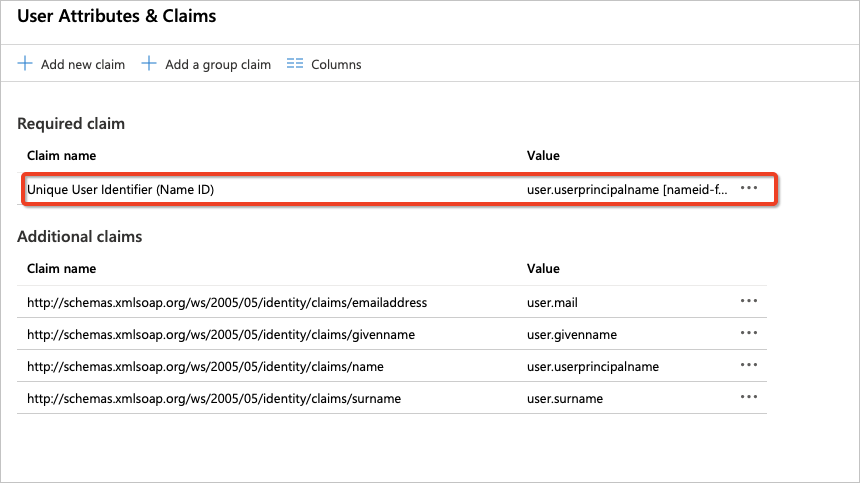
b. Atlassian Cloud expects the nameidentifier (Unique User Identifier) to be mapped to the user's email (user.email). Edit the Source attribute and change it to user.mail. Save the changes to the claim.
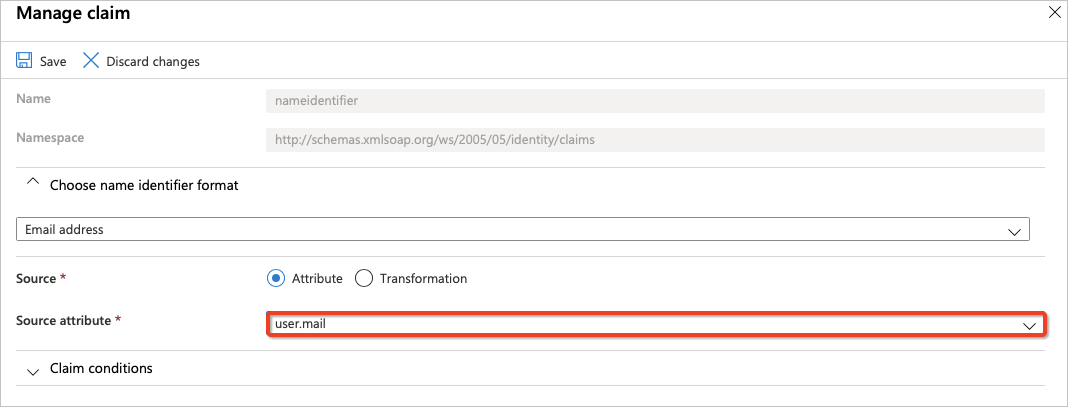
c. The final attribute mappings should look as follows.

Attribute mapping for a Microsoft Entra tenant without a Microsoft 365 license.
a. Click on the
http://schemas.xmlsoap.org/ws/2005/05/identity/claims/emailaddressclaim.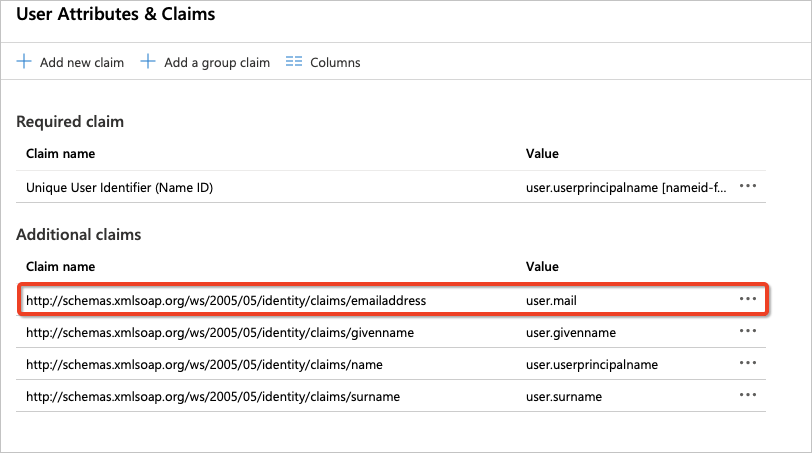
b. While Azure does not populate the user.mail attribute for users created in Microsoft Entra tenants without Microsoft 365 licenses and stores the email for such users in userprincipalname attribute. Atlassian Cloud expects the nameidentifier (Unique User Identifier) to be mapped to the user's email (user.userprincipalname). Edit the Source attribute and change it to user.userprincipalname. Save the changes to the claim.

c. The final attribute mappings should look as follows.

Click Stop and save SAML button.

To enforce SAML single sign-on in an authentication policy, perform the following steps.
a. From the Atlassian Admin Portal, select Security tab and click Authentication policies.
b. Select Edit for the policy you want to enforce.
c. In Settings, enable the Enforce single sign-on to their managed users for the successful SAML redirection.
d. Click Update.

Note
The admins can test the SAML configuration by only enabling enforced SSO for a subset of users first on a separate authentication policy, and then enabling the policy for all users if there are no issues.
Create a Microsoft Entra test user
In this section, you'll create a test user called B.Simon.
- Sign in to the Microsoft Entra admin center as at least a User Administrator.
- Browse to Identity > Users > All users.
- Select New user > Create new user, at the top of the screen.
- In the User properties, follow these steps:
- In the Display name field, enter
B.Simon. - In the User principal name field, enter the username@companydomain.extension. For example,
B.Simon@contoso.com. - Select the Show password check box, and then write down the value that's displayed in the Password box.
- Select Review + create.
- In the Display name field, enter
- Select Create.
Assign the Microsoft Entra test user
In this section, you'll enable B.Simon to use single sign-on by granting access to Atlassian Cloud.
- Sign in to the Microsoft Entra admin center as at least a Cloud Application Administrator.
- Browse to Identity > Applications > Enterprise applications > Atlassian Cloud.
- In the app's overview page, select Users and groups.
- Select Add user/group, then select Users and groups in the Add Assignment dialog.
- In the Users and groups dialog, select B.Simon from the Users list, then click the Select button at the bottom of the screen.
- If you are expecting a role to be assigned to the users, you can select it from the Select a role dropdown. If no role has been set up for this app, you see "Default Access" role selected.
- In the Add Assignment dialog, click the Assign button.
Create Atlassian Cloud test user
To enable Microsoft Entra users sign in to Atlassian Cloud, provision the user accounts manually in Atlassian Cloud by doing the following steps:
Go to Products tab, select Users and click Invite users.

In the Email address textbox, enter the user's email address, and then click Invite user.

Test SSO
In this section, you test your Microsoft Entra single sign-on configuration with following options.
SP initiated:
Click on Test this application, this will redirect to Atlassian Cloud Sign-on URL where you can initiate the login flow.
Go to Atlassian Cloud Sign-on URL directly and initiate the login flow from there.
IDP initiated:
- Click on Test this application, and you should be automatically signed in to the Atlassian Cloud for which you set up the SSO.
You can also use Microsoft My Apps to test the application in any mode. When you click the Atlassian Cloud tile in the My Apps, if configured in SP mode you would be redirected to the application sign-on page for initiating the login flow and if configured in IDP mode, you should be automatically signed in to the Atlassian Cloud for which you set up the SSO. For more information about the My Apps, see Introduction to the My Apps.
Next steps
Once you configure Atlassian Cloud you can enforce session control, which protects exfiltration and infiltration of your organization's sensitive data in real time. Session control extends from Conditional Access. Learn how to enforce session control with Microsoft Defender for Cloud Apps.
Feedback
Coming soon: Throughout 2024 we will be phasing out GitHub Issues as the feedback mechanism for content and replacing it with a new feedback system. For more information see: https://aka.ms/ContentUserFeedback.
Submit and view feedback for